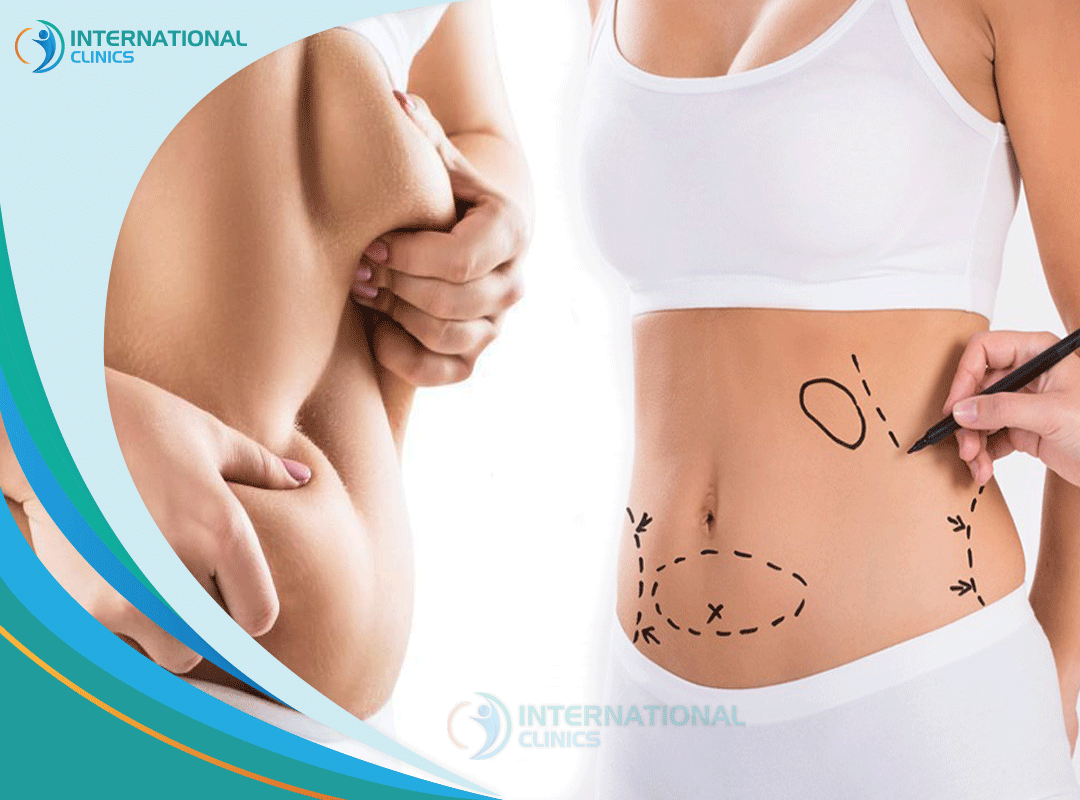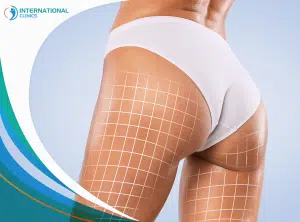Abdominoplasty (or tummy tuck) has earned a significant place in the scope of cosmetic procedures as it offers a transformative solution for those seeking to refine their abdominal contours.
However, it’s not performed merely for “aesthetics”; indeed, this surgery can also address functional concerns such as diastasis recti, where the abdominal muscles have separated due to pregnancy among women, or weight fluctuations among both men and women.
Nonetheless, the idea of undergoing a tummy requires a thorough evaluation of one’s health and a clear understanding of the processes involved. But, for those who choose this path, the benefits are diverse.
Surgeons have developed various techniques for tummy tuck to minimize scarring and enhance recovery, making the procedure more appealing to a broader demographic.
Tummy tuck can in fact lead to improved posture, reduced back pain, and a more positive self-image. The evolution of abdominoplasty can be traced back to the early 20th century when surgeons began to explore methods to remove excess abdominal skin for both aesthetic and health reasons.
However, it wasn’t until the latter half of the century that the procedure gained widespread popularity, thanks in part to the increasing value placed on physical appearance and fitness.
The procedure’s ability to reshape the abdominal area has solidified its status as a great solution for those seeking to improve their body contour.
What Is Abdominoplasty?
Simply speaking, abdominoplasty is a surgical procedure to reshape and firm the abdominal region. Some people consider it a reconstructive surgery to remove excess skin and fat and tighten the muscles in the abdominal wall.
Save your time and get all the details in one click with your free consultation
Important to say here that abdominoplasty isn’t a substitute for weight loss or an appropriate exercise program.
Nonetheless, for those who have experienced significant weight loss, pregnancy, or aging, and are left with loose skin that doesn’t respond to diet or exercise, abdominoplasty can be a good option.
The goal of abdominoplasty is simply to create a smoother, firmer abdominal profile, which can lead to increased confidence and comfort in one’s own body.
Patients, however, must have realistic expectations and understand that, while the results are typically long-lasting, maintaining a stable weight is essential for preserving the effects of the surgery.
Types of Tummy Tuck
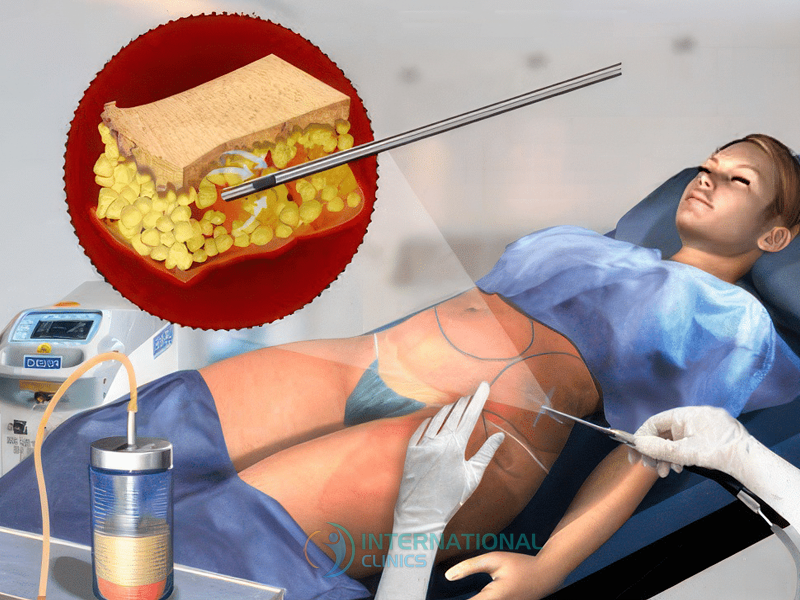
Abdominoplasty comes in different forms or types and each of these types is designed to address specific concerns or aesthetic goals.
Choosing the right technique depends on factors such as the amount of excess skin, the condition of the abdominal muscles, and the patient’s overall health. Nonetheless, here are the main types of tummy tuck procedures:
Complete or Full Abdominoplasty
This form of tummy tuck is ideal for those who require extensive correction. However, it involves an incision from hip to hip, just above the pubic area, and another around the navel.
Your surgeon will remove excess skin, tighten the abdominal muscles, and reposition the belly button to fit the new contour. Nonetheless, this type is typically recommended for those who have been through pregnancy or significant weight loss.
Partial or Mini Abdominoplasty
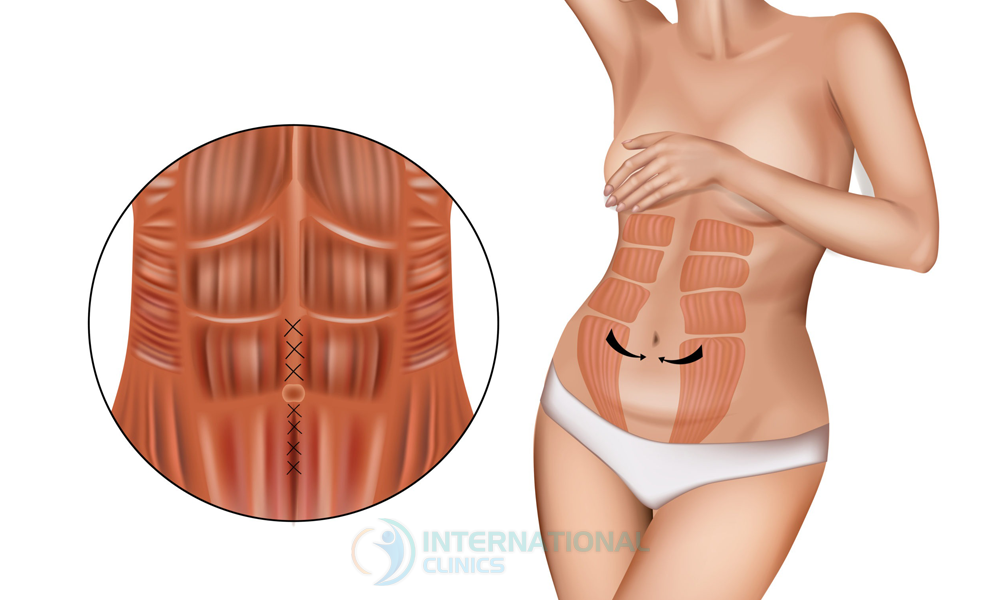
Suited for those with fat deposits located below the navel, the mini tummy tuck requires a smaller incision compared to the full tummy tuck.
However, it often doesn’t involve repositioning the navel, and the recovery time is often shorter, but the results are less satisfactory than a complete abdominoplasty.
Extended Abdominoplasty
This technique is often seen as an “extension” of full abdominoplasty and could include the flanks or the lower back. The surgeon usually recommends it for those who have lost a significant amount of weight and have excess skin extending around the sides of their torso.
Fleur-de-Lis Abdominoplasty
This type of tummy tuck is less common compared to other types, but it can be used for post-bariatric patients with substantial amounts of excess skin.
Ideal Candidates for Tummy Tuck Surgery
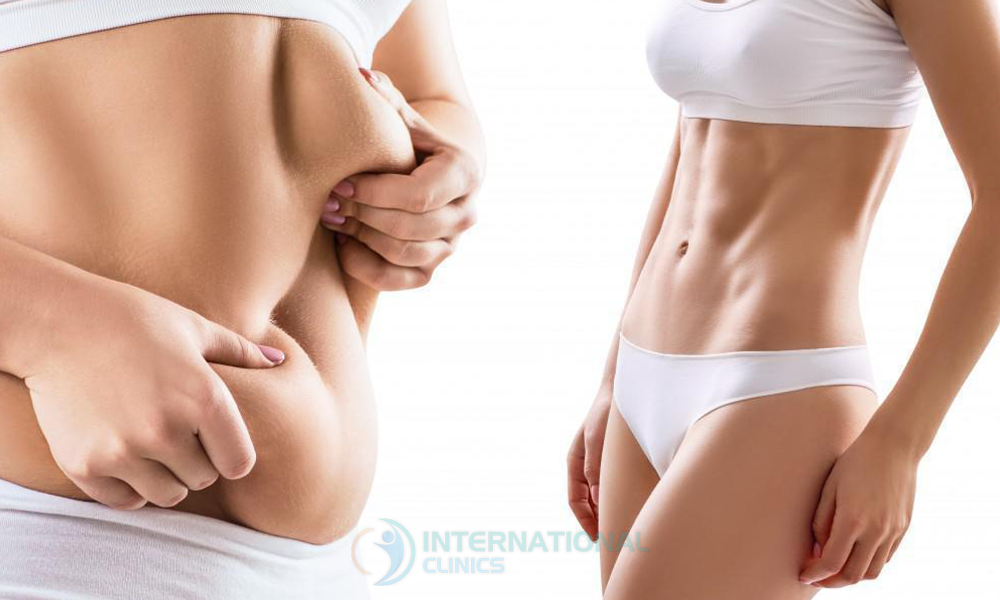
From surgeons’ perspective, choosing the ideal candidates for tummy tuck surgery is very important to ensure optimal outcomes.
It’s clear now that not everyone is a suitable candidate for this procedure. Nonetheless, ideal candidates include:
- Those in good general health: Ideal candidates should be in good physical health to minimize the risk of complications. It’s understandable that underlying health conditions may affect eligibility for the procedure.
- Those at a stable weight: Candidates should be at or near their ideal weight. Significant fluctuations in weight aren’t acceptable as they can affect the results of the surgery. Hence, maintaining a stable weight (both before and after the procedure) is essential for long-lasting results.
- Those with excess abdominal skin: Those who have excess skin that has not responded to diet and exercise are also good candidates. Often, this is the case after pregnancy and significant weight loss.
- Non-smokers: Smoking affects healing and increases the risk of complications after all types of surgery. Thus, those who are non-smokers or, at least, willing to quit smoking in advance of the surgery are considered ideal.
- People with weak abdominal muscles: A tummy tuck can repair and tighten these muscles. Usually, this is beneficial for women after pregnancy or those who have experienced diastasis recti.
- Patients with realistic expectations: Candidates should have a realistic view of what the surgery can achieve and understand that it isn’t a weight-loss procedure.
Stay safe and informed with expert advice from our specialized doctors. Contact us on WhatsApp today!
Preparing for Abdominoplasty
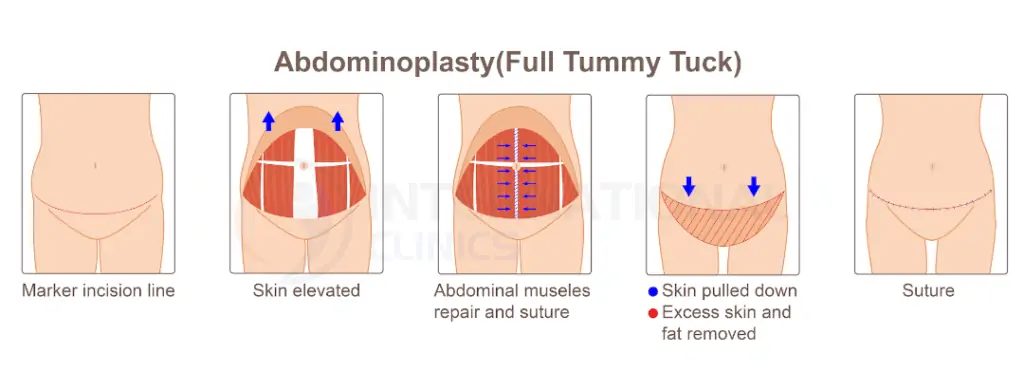
The process of abdominal plastic surgery or abdominoplasty starts before the patient enters the operating room. Like any other procedure, there are several preparatory steps.
- First, you need to choose a qualified, board-certified plastic surgeon with extensive experience in abdominoplasty procedures. Investigate the surgeon thoroughly, especially their training, credentials, and before-and-after photos of past patients.
- Have an in-depth consultation with your surgeon to discuss your medical history, goals for surgery, and reasonable expectations for results. Be open about concerns and let your surgeon address them clearly.
- Get transparent medical clearances from primary care doctors and specialists, particularly those who manage health conditions like diabetes or heart disease. Stop smoking and avoid blood-thinning medications, supplements, alcohol, and drugs for several weeks.
- Finally, prepare the necessary help for the recovery period for at least 2-4 weeks after the procedure. Have healthy foods available, for example, and set up your home.
The Abdominoplasty Procedure Explained
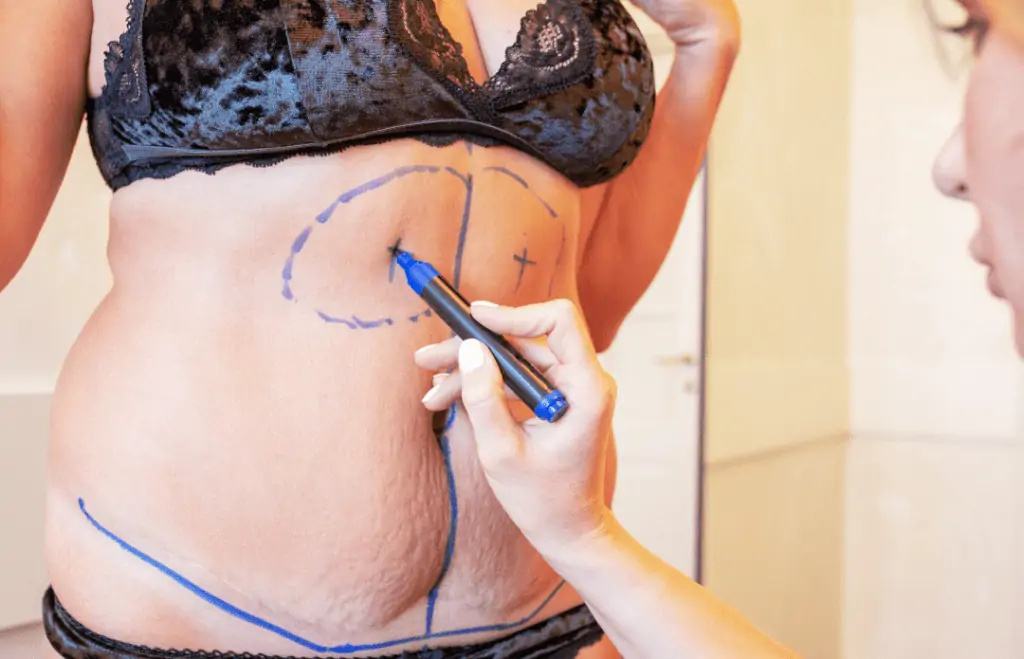
Abdominoplasty sculpts the abdomen by removing excess fat and skin and tightening muscles.
When performed by a skilled, board-certified plastic surgeon, the procedure can effectively refine the midsection. The procedure involves several surgical steps, including:
- First, the surgeon makes an incision just above the pubic area, usually from hip to hip. The length and type of incision vary based on factors like the degree of correction needed and your unique anatomy.
- Next, another incision frees the navel from the surrounding skin so it can be repositioned. The surgeon may also perform liposuction on the flank areas to enhance contouring before making the incisions.
- After detaching the skin, the surgeon can access the abdominal muscles beneath. Damaged or separated muscles are stitched back together, creating a ‘corset’ effect for a trimmer, tighter abdomen.
- Finally, the surgeon “re-drapes” the remaining skin over the newly contoured area and repositions the navel. Drains may be placed temporarily underneath the skin leading down to fluid reservoirs to prevent postoperative buildup.
Need personalized medical advice? Contact us now.
Risks and Complications of Tummy Tuck Surgery
Abdominoplasty or “tummy tuck” surgery delivers improvements to abdominal contours, but it doesn’t come without some risks.
Bleeding
This could happen during or after surgery and may require additional procedures to drain fluid accumulations or stop bleeding sites. Although very rare, large-volume hemorrhages are urgent medical emergencies.
Infection
Infections usually respond to antibiotic treatment but may form abscesses that need drainage. Luckily, infections occur infrequently when sterilization protocols are strictly followed.
Poor wound healing
Healing capacity varies between people and relates to many factors. Smokers face a much higher chance of skin loss and wider scarring.
Visible scarring
While surgeons can later revise problematic scars, preventing poor healing remains the right preventive measure to avoid large scar formations.
Asymmetry
The most skilled surgeons aim for evenly balanced results. However, some asymmetry may persist. Many patients deem small discrepancies acceptable, yet revisions provide an option down the road.
Recurrence of abdominal muscle separation
Pregnancy, for instance, can reverse a surgically tightened abdomen.
Do you want to avoid all these risks?? Get your free consultation now
Recovery and Aftercare Following Abdominoplasty

Abdominoplasty’s recovery requires dedication and following certain tips, such as:
Adequate Rest
A few weeks might feel challenging, even with help. You should balance lots of lying down with brief, gentle walks. Listen to your body above all; don’t push yourself too quickly.
Managing Pain Properly
The doctor prescribes medication to relieve the discomfort. Over-the-counter options work for some. No matter what, don’t let pain intensify without addressing it.
Keeping Incision Sites Clean
Avoid soaking wounds in water; use a sponge bath instead. Check for signs of infection constantly, such as redness, oozing, and worsening pain.
Wearing Compression Garments
The bindings provide structure while healing, meaning that a proper fit can prevent discomfort. Keep garments on as directed, only removing them briefly. The compression can minimize ongoing swelling and support desired contours.
Attending All Follow-Up Visits
Surgeons monitor recovery milestones at regular intervals. They ensure proper healing while addressing any concerns. Smooth recoveries let patients start appreciating their rejuvenated shapes that much sooner after all.
Cost Analysis of Tummy Tuck Surgery

By breaking down the factors that make up the total cost of tummy tuck surgery, patients can learn how to wisely manage and understand their financial case.
- Surgeon’s fee: This can vary greatly based on the surgeon’s level of experience and location. Highly complex surgery over 4-6 hours involving muscle repair or contouring costs more. Above all, the surgeon’s fee accounts for the largest portion. This fee covers time in surgery, typically ranging from 5,000 to 10,000 US dollars in the US, or 1000-2000 US dollars in Turkey.
- Facility fees: Operating room, equipment costs, nursing staff, and other medical services can come at a cost between 700-1500 US dollars.
- Anesthesia fees: Whether general or local anesthesia with sedation, the cost of this important step can range between 800-1500 US dollars.
- Garments: Post-op compression garments provide support while healing for about 50-100 US dollars each.
- Medications: Pain relievers, antibiotics, and other meds run approximately 50-100 US dollars.
Read more about: liposuction and tummy tuck cost
Worried about costs? Get in touch on WhatsApp to discuss affordable medical options
Choosing the Right Surgeon and Clinic

Not every surgeon or clinic can provide trusted plastic procedures such as tummy tuck. It’s very important to carefully research the right plastic surgeon and clinic for a tummy tuck, especially if you choose to have it abroad. There are many factors to consider when searching, such as
- Verify board certification in plastic surgery: This rigorous, intensive certification process validates that the surgeon has undergone years of specialized training and education, and performed numerous similar surgeries.
- Seek significant experience with tummy tucks: Ask detailed questions, like how many abdominoplasties do they conduct annually? What’s their personal success and complication rate? Can they share before/after photos of past patients who’ve consented?
- Examine review: Manner can deeply impact your care experience and results. Seek a compassionate, attentive listener who makes you feel heard and cared for.
- Tour the surgical facilities: Ask about accreditations and standards to ensure stringent health, safety, and sanitation practices. Have they been written about in industry journals favorably? The materials, nursing staff competency, and protocols should give you confidence you’ll be safe and comfortable.
- Ensure aftercare support: Your recovery will span weeks to months, requiring follow-ups to monitor your progress healing properly. Expect regular check-ins, and prompt responses if any issues emerge and help manage pain, drain removal, swelling, and more during the lengthy recovery ahead.
Frequently Asked Questions
A tummy tuck and abdominoplasty are two terms for the same procedure, which is a surgery to improve the appearance of the abdomen by removing excess fat and skin and tightening muscles in the abdominal wall.
The main types of tummy tuck procedures include full tummy tuck, mini tummy tuck, and extended tummy tuck, among other less-performed types.
Ideal candidates for a tummy tuck are in overall good health with stubborn excess fat or loose skin in the abdomen that doesn’t respond to diet and exercise.
Yes, tummy tuck surgery is very commonly performed on women, especially after pregnancy.
On average, tummy tuck surgery takes between 2-5 hours, depending on the extent of the procedure planned.
Important post-tummy tuck care includes wearing the prescribed compression garment for 4-6 weeks, gradually increasing physical activity starting with walking, avoiding strenuous activity for ~6 weeks post-surgery, and keeping incision sites clean and cared for properly.
Yes, when consulting with your plastic surgeon, you can specify areas of concern you want addressed with a tummy tuck procedure.
Conclusion
Abdominoplasty (tummy tuck) is a common procedure in cosmetic surgery, offering hope for those seeking to reshape their abdomen muscles and skin. However, it’s not a bariatric procedure; besides, the procedure’s success hinges on the skill of the surgeon and the pre-and post-operative care.
Beyond the visual or cosmetic improvements, the procedure offers functional benefits such as enhanced core stability and relief from certain physical discomforts.
People often experience a boost in self-esteem and body image after having the procedure. As is the case with other plastic procedures, there is a diversity of techniques available for tummy tucks: from complete to partial tummy tucks, each type of tummy tuck can address specific needs and goals.
The ideal candidates are those who are at a stable weight, non-smokers and possess a realistic outlook on the surgery’s results. In any case, abdominoplasty isn’t just a passing procedure; it is a long-term commitment to maintaining the results through a healthy lifestyle.
